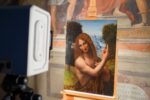Peter Downsbrough – Four walls. One room
.jpg)
Mostra personale.
Comunicato stampa
PETER DOWNSBROUGH | FOUR WALLS – ONE ROOM
Peter Downsbrough’s Two Pipes (installed outside) and Two Poles (installed inside) are two sculptural versions of the Two Lines that indicate a space, a possible location where the work could be placed or imagined. In fact, Downsbrough’s work is rooted in these very indicators of position: the reference to the space is the artwork, or rather the artwork is the space, in a reversal of perception.
Like other conceptual artists of his time who did not make actual works, preferring simply to describe them, Downsbrough indicates the position they could occupy; he offers suggestions and forces us to choose: This or that? Here or there? As, And, Then..as we read in some of his texts, which always employ the same clean, linear font. It is up to us to understand, if we choose: for that matter, in order to grasp the world around us, we must know where we ourselves are situated.
Peter Downsbrough began his career in New York in the early 1960s, and in the years since, his Notes on Location have gone down in art history. After several years of work and exploring on materials, including cardboard, wood, steel, lead and neon tubing, Peter Downsbrough (1940, New Brunswick, NJ) began his research in 1970 with Two Pipes, Two Lines, Two Poles, summarized in his first artist book Notes on Location (1972). A few years later, he also started taking photographs from different angles and distances of “cuts” that already existed in the urban landscape. The first audio work, FROM, was released as vinyl in 1982, and a series of works made with dice date back to the late 1970s.
In 1980 he made a 30-second spot for the Spectacolor Board on Times Square in New York that was shown once every hour, and documented this piece in a short film entitled “7 come 11”. In the same years he also started using regular postcards, initially by applying two lines, later to be followed by the use words as well. The work with the maquette as a means to explore space and structures begins around 1983, and the Wall Pieces and Room Pieces around the mid-eighties. The first public commission, UNITE/DE, LA, was realized in Rennes in 1990.
PETER DOWNSBROUGH | FOUR WALLS – ONE ROOM
Two Pipes (quando posizionate all’esterno) e Two Poles Dowels (quando installate all’interno) sono le versioni scultore delle Two Lines che indicano lo spazio e il riferimento a un possibile luogo dove l’opera si potrebbe installare o immaginare. In realtà il lavoro di Peter Downsbrough nasce da quegli stessi indicatori di posizione: il riferimento allo spazio è l’opera, anzi l’opera è lo spazio, ribaltando la percezione.
Come altri artisti concettuali del periodo che non creavano opere ma si limitavano a descriverle solamente, Downsbrough indica la posizione che si potrebbe occupare, suggerisce delle indicazioni e costringe a scegliere: This or that? Here or there? As, And, Then... come citano anche i suoi testi, sempre con lo stesso rigoroso font, pulito e lineare. A noi spetta la scelta di capire, o voler capire: d’altronde per cogliere il mondo intorno, ciascuno deve sapersi situare e ritrovare. Peter Downsbrough ha iniziato la sua ricerca a New York agli inizi degli anni ‘60 e le sue Notes on Location da allora sono divenute storia.
Peter Downsbrough (1940, New Brunswick, N.J.) dopo diversi anni di lavoro e di sperimentazioni sui materiali, tra cui cartone, legno, acciaio, piombo e tubi al neon, nel 1970 inizia la sua ricerca con Two Pipes, Two Lines, Two Poles Dowels, riassunte nel suo primo libro d’artista Notes on Location (1972). Nello stesso periodo inizia a scattare fotografie da diverse angolazioni e distanze, riprendendo “tagli” che già esistono nel paesaggio urbano. Alla fine degli anni ‘70 risalgono il primo lavoro audio, FROM, pubblicato come vinile nel 1982, e una serie di lavori realizzati con i dadi.
Nel 1980 proietta sulla Spectacolor Board di Times Square a New York uno spot di 30 secondi che appare una volta ogni ora e lo documenta in un cortometraggio dal titolo “7 come 11”. Negli stessi anni inizia a spedire cartoline con due linee che tagliano i paesaggi, completate successivamente dall’utilizzo di parole. Il lavoro con le maquette come mezzo per esplorare lo spazio e la struttura inizia intorno al 1983, mentre dalla fine degli anni ’80 iniziano le opere pubbliche su commissione e i Wall Pieces e i Room Pieces. A Rennes, nel 1990, realizza UNITE/ DE, LA, la sua prima opera pubblica su commissione.



